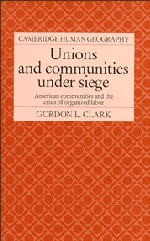Book contents
- Frontmatter
- Contents
- List of tables
- Preface
- Acknowledgments
- PART I ECONOMY AND COMMUNITY
- PART II DRAMA OF ECONOMIC RESTRUCTURING
- PART III UNION PERFORMANCE IN REPRESENTATION ELECTIONS
- 5 Democracy in the guise of representation elections
- 6 Organizing strategies in the heartland and the South
- 7 At the margin of the rules of the game
- PART IV REGULATING LOCAL LABOR–MANAGEMENT RELATIONS
- PART V PROSPECTS FOR ORGANIZED LABOR
- Appendix 1 Variables and data sources
- Appendix 2 Cases cited
- Notes
- Bibliography
- Name index
- Subject index
6 - Organizing strategies in the heartland and the South
Published online by Cambridge University Press: 13 October 2009
- Frontmatter
- Contents
- List of tables
- Preface
- Acknowledgments
- PART I ECONOMY AND COMMUNITY
- PART II DRAMA OF ECONOMIC RESTRUCTURING
- PART III UNION PERFORMANCE IN REPRESENTATION ELECTIONS
- 5 Democracy in the guise of representation elections
- 6 Organizing strategies in the heartland and the South
- 7 At the margin of the rules of the game
- PART IV REGULATING LOCAL LABOR–MANAGEMENT RELATIONS
- PART V PROSPECTS FOR ORGANIZED LABOR
- Appendix 1 Variables and data sources
- Appendix 2 Cases cited
- Notes
- Bibliography
- Name index
- Subject index
Summary
From all the data so far presented, it is apparent that the American labor movement is in the grips of a profound crisis. Unions are winning proportionally fewer representation elections, contesting fewer elections, and winning in smaller units. These patterns are especially evident in the electoral performance of industrial production-oriented unions in the northern industrial states over the past ten years. Since the early 1950s, it has often been asserted that the union movement would inevitably decline because of its lack of appeal to the growing service-sector occupations and to the southern region of the US. And yet, some thirty years later, it seems that the union movement is most vulnerable in those sectors and areas once thought to be the heartland of American unionism.
In the previous chapter it was noted that there are distinct differences between unions in their organizing strategies. For example, the IBEW has concentrated on skilled tradesmen in a variety of electrical-oriented sectors located across the US. In contrast, the UAW has concentrated on a group of auto-related industries located in just a few regions. One goal of this chapter is to provide a rationale for this organized strategy. Most of the literature fails to integrate the macro-structural determinants of unionization with the local context of representation elections. The geographical diversity of representation elections, so obvious in election outcomes, seems too often lost in the rush to prove single equation (parsimonious) models of unionization.
- Type
- Chapter
- Information
- Unions and Communities under SiegeAmerican Communities and the Crisis of Organized Labor, pp. 110 - 129Publisher: Cambridge University PressPrint publication year: 1989



